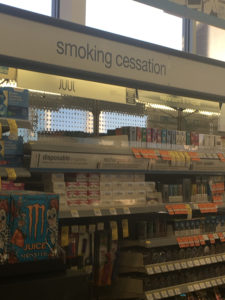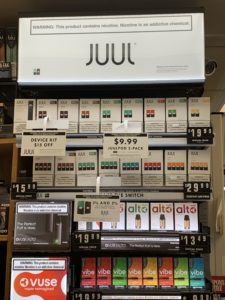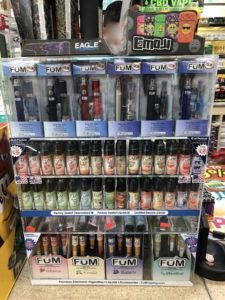Welcome to CounterTobacco.org’s “News and Research Roundup!” Each month we post a summary of the latest research, reports, and news stories on counteracting tobacco product sales and marketing at the point of sale (POS). Keeping up with what’s happening in the POS movement all across the country can help you choose policies and strategies that work best for your community. New research can help provide support for your work and evidence for the importance of the “War in the Store.” Have a story you don’t want us to miss? E-mail it to us!
New Research
Point of Sale
- Assessing the relationship between retail store tobacco advertising and local tobacco control polic
 ies: A Massachusetts case study, Journal of Environmental and Public Health
ies: A Massachusetts case study, Journal of Environmental and Public Health
- Researchers assessed the prevalence of tobacco ads in 419 retail stores in 42 municipalities across Massachusetts. They found that 86.6% of all retail stores had tobacco ads, with 2,804 ads in total and an average of 6.7 ads at each retail store. Ad categories that were most prevalent included power walls and e-cigarette ads. The odds of retailers having fewer ads related to tobacco products was 8% less in localities with more comprehensive tobacco control policies compared to other jurisdictions. As well, the odds of a retail store having all tobacco ad categories was 12% lower in localities with more comprehensive tobacco control policies. These findings suggest that more comprehensive tobacco control policies could lead to reductions in tobacco advertisements, and ultimately, reductions in smoking in these localities. Learn more about restricting tobacco advertisements in the retail environment.
- Assessment of the US federal retailer violation rate as an estimate of the proportion of retailers that illegally sell tobacco to adolescents, JAMA Pediatrics
- To evaluate the validity of the publicized federal retailer violation rate, researchers observed attempts of supervised minors to purchase cigarettes from 201 retailers, including convenience stores, liquor stores, grocery stores, pharmacies, tobacco stores, and gas stations, in a suburb in Colorado. Purchase attempts were made six times at each retailer. Across the six rounds of purchase attempts, 54.7% of retailers had at least one violation, 26.4% had at least two violations, and 11.9% had three or more violations. Whether violations occurred was largely dependent on whether, and how, retailers examined proof of age. This study emphasizes the need for retailer education and the importance of compliance checks and strong enforcement for tobacco control policies to be effective and successful. Learn more about licensing which is a great tool for enforcement.
- Tobacco-free pharmacies and U.S. adult smoking behavior: Evidence from CVS Health’s Removal of Tobacco Sales, American Journal of Preventative Medicine

- CVS pharmacies stopped selling tobacco products in all of its retail stores in the U.S. in September of 2014. To assess the impact of the removal of tobacco products from CVS stores, researchers, utilizing data from the Behavioral Risk Factor Surveillance System, looked at the association between smoking quit attempts and density of CVS retailers in the two years following the new store policy. They found that smokers who lived in counties with a high density of CVS stores had a 2.21% increase in quit attempts compared to smokers living in counties with no CVS stores. This effect was particularly strong in urban areas. These findings suggest that by ending tobacco product sales, pharmacies may influence adults’ smoking cessation attempts. Learn more about tobacco-free pharmacies.
Mint, Menthol and Other Flavored Tobacco Products
- Flavors of e-cigarettes used by youths in the United States, JAMA
- Utilizing data form the Monitoring the Future survey, researchers estimated the use of various Juul flavors by youth in 2019. Of those sampled, 18.8% of youth reported vaping any nicotine product within the past 30 days. Among eight graders who vaped a Juul product in the past 30 days, the most common flavors vaped were mango (33.5%), mint (29.2%), and fruit (16.0%); among tenth graders, mint (43.5%), mango (27.3%) and fruit (14.8%); and among twelfth graders, mint (47.1%), mango (23.8%) and fruit (8.6%). This study highlights the popularity of mint, and not just fruit flavored Juul products, with youth. Learn more flavored tobacco products.
- News story: Over 5 million children and teens are vaping in the U.S., researchers say, CBS News
- Evaluating the effect of switching to non-menthol cigarettes among current menthol smokers: An empirical study of a potential ban on characterising menthol flavour in cigarettes, Tobacco Control
- From 2017-2018, 29 non-treatment-seeking adults who smoked menthol cigarettes were recruited to participate in this study that assessed changes in smoking behavior when switching from menthol to non-menthol cigarettes, as a way to simulate a possible menthol ban. Over the two-week period, participants smoked significantly fewer non-menthol cigarettes than the menthol ones they had been smoking (mean decrease=2.2). Participants also had significantly lower nicotine dependence (reduced by >18%), and reported greater motivation and confidence to quit smoking. These findings were more pronounced when broken down by race, with Black smokers having significantly greater reductions in number of cigarettes smoked per day after switching from menthol to non-menthol cigarettes than non-Black smokers. Learn more about menthol products.
- No surge in illicit cigarettes after implementation of menthol ban in Nova Scotia, Tobacco Control
- In May 2015, the province of Nova Scotia in Canada banned the sale of menthol cigarettes; the
tobacco industry argued that implementing this policy would increase illegal cigarette trade in the province. This study compared the number of illicit cigarettes seized before and after the menthol cigarette ban and found no significant difference in the number of illicit cigarettes seized, suggesting that implementation and enforcement of a menthol cigarette ban would not increase illicit cigarette trade. Learn more about restricting tobacco product availability.
- In May 2015, the province of Nova Scotia in Canada banned the sale of menthol cigarettes; the
- Adults’ favorability toward prohibiting flavors in all tobacco products in the United States, Preventive Medicine
- Data from the 2016 Summer Styles survey of US adults assessed attitudes towards prohibiting flavors in all tobacco products, including e-cigarettes; overall, nearly half of adults sampled reported positive attitudes towards such a ban. Never and former users of tobacco products had more favorable attitudes towards prohibiting flavors than current users, and positive attitudes were more likely to be reported among those with youth in the household and those who believed e-cigarette ads influenced youth. Learn more flavored tobacco products.
E-Cigarettes
- Flavored e-cigarette use and progression of vaping in adolescents, Pediatrics
- Through five semiannual surveys with high school students in Los Angeles, researchers assessed high school students’ use of non-traditional flavored (e.g. fruit, candy, sweet) and traditional flavored (e.g. tobacco, mint, menthol) e-cigarette products. They found that those who used non-traditional flavored e-cigarette products, compared to those who used traditional flavored products, had significantly greater odds of continued vaping (64.3% of non-traditional flavor users vs. 42.9% of traditional flavor users) and more inhalations per vaping session (average 3.1 puffs for non-traditional flavor users vs. 1.5 puffs for traditional flavor users) when measured six months later. Learn more about
 flavored tobacco products.
flavored tobacco products. - News Story: Fruity flavors lure teens into vaping longer and taking more puffs, study says, Los Angeles Times
- Through five semiannual surveys with high school students in Los Angeles, researchers assessed high school students’ use of non-traditional flavored (e.g. fruit, candy, sweet) and traditional flavored (e.g. tobacco, mint, menthol) e-cigarette products. They found that those who used non-traditional flavored e-cigarette products, compared to those who used traditional flavored products, had significantly greater odds of continued vaping (64.3% of non-traditional flavor users vs. 42.9% of traditional flavor users) and more inhalations per vaping session (average 3.1 puffs for non-traditional flavor users vs. 1.5 puffs for traditional flavor users) when measured six months later. Learn more about
- Nicotine arms race: JUUL and the high-nicotine product market, Tobacco Control
- This study looked at the extent which high nicotine concentration Juul pods impacted the market of e-liquids with high nicotine concentrations. Researchers found 14 Juul compatible pods and 39 Juul knock-off devices that provided equal or higher nicotine concentrations than Juul. As well, more than 70 e-liquid brands sell high products in bulk (greater than 30mL). The study evidences the surge in products with high nicotine concentrations currently on the market. Learn more about e-cigarettes at the point-of-sale.
- E-cigarette use among youth in the United States, 2019, JAMA
- This cross-sectional survey of close to 20,000 participants found the prevalence of self-reported e-cigarette use to be 27.5% among high school students and 10.5% among middle school students. Learn more about e-cigarettes at the point-of-sale.
- News story: Study reports high use of electronic cigarettes among US students in 2019, EurekAlert!
Other
- Antismoking advertisements and price promotions and their association with the urge to smoke and purchase in a virtual convenience store: Randomized experiment, Journal of Medical Internet Research
- Using a virtual convenience store, this study assessed the impact of antismoking ads (either a graphic image of physical consequences of tobacco use, a supportive quit message from a former smoker, or no ad) and price promotions (present or absent) on the urge to smoke and on tobacco purchase behaviors for current and former cigarette smokers. The study found that current smokers who saw supportive antismoking ads in the virtual convenience story were significantly less likely to report an urge to smoke. While the other interactions were not statistically significant, this finding suggests that supportive ads in the retail environment could help decrease the urge to smoke for current cigarette smokers. Learn more about restricting tobacco advertising and promotion.
- Youth access to tobacco products in the Unites States, 2016-2018, Tobacco Regulatory Science
- Data from the 2016-2018 National Youth Tobacco Surveys determined that youth ages 9-17 who used tobacco products in the last 30 days most often obtained tobacco products from social sources. As well, during this time period, the percentage of these youth who reported purchasing tobacco products significantly decreased (15.6% in 2016 to 11.4% in 2018), though there was no significant difference in the prevalence of youth who reported being refused sale of tobacco products, which remained at only 1 in 4. Learn more about industry tactics targeting youth.
New Reports
- U.S. Tobacco Industry Interference Index 2019. This report, published by Action On Smoking and Health and the Oklahoma Tobacco Research Center, assess the ways in which the tobacco industry has interfered with public health policy in America, including examples of tobacco industry interference and influence on specific states’ policies.
Industry News
- Juul marketing chief leaves as e-cigarette maker suspends advertising, The Wall Street Journal
- Altria writes down investment in troubled e-cigarette maker Juul by $4.5 billion, CNBC
- FTC probes Altria for role in Juul executive changes, Reuters
- Juul disregarded early evidence it was hooking teens, Reuters
- Juul halts sales of its popular mint flavor, CNBC
- Juul Labs job cuts higher than projected at 650, Journal Now
- Altria opening first store in Richmond for alternative smoking device iQOS on Saturday, Richmond Times-Dispatch
POS Policy in the Media
Menthol and Other Flavored Tobacco
Federal
- As Trump tackles vapes, African Americans feel stung by inaction on menthol cigarettes, The Washington Post
- Federal bill banning non-tobacco flavorings, raising minimum age to 21 clears first step, Winston-Salem Journal
- Trump’s vaping ban is stalled after an industry lobbying push, Bloomberg Law
- Trump retreats from flavor ban for e-cigarettes, The New York Times
- Bill to ban all non-tobacco flavorings for tobacco products gets recommendation in U.S. House committee, Winston-Salem Journal
State
- Minnesota lawmakers look to outlaw flavored tobacco, ban online vape sales, Duluth News Tribune
- N.J. advances ban on flavored e-cigarettes and menthols, WBGO
- Massachusetts moves to ban flavored tobacco products, including menthol, The New York Times
- Lawmakers propose ban on menthol cigarettes, The Post-Journal (New York)
Local
- Amherst health board seeks to move menthol smokes to adult-only stores, Amherst Bulletin
- The City of Woodland bans the sale of flavored tobacco products, ABC10
- Ban on flavored tobacco products fails in Albany County, Times Union
- Culver City bans sale of flavored/menthol tobacco products, Patch
- Contra Costa County bans sales of e-cigarettes, flavored tobacco, East Bay Times
- City Council extends moratorium on flavored tobacco products, SCV News

E-Cigarettes
- Repeal of SF e-cigarette ban, once backed by Juul, is overwhelmingly rejected by voters, San Francisco Chronicle
- Former FDA commissioner calls for a full ban on pod-based e-cigarettes, STAT
- Utah Health Department will create new e-cig rules after judge halts emergency restrictions on flavored vaping products, The Salt Lake Tribune
- Council gives first approval for tobacco business buffer zone, Press Herald
- Broomfield passes smoking, vaping laws, Broomfield Enterprise
- Bay Area county bans e-cigarettes to combat the vaping industry ‘preying on our children’, The Mercury News
- Manhattan Beach bans sale of vape products amid reports of illnesses and deaths, The Beach Reporter
- E-cigarettes, vaping products won’t be for sale in these 2 SLO County cities next year, The Tribune
- Vaping may be worse for health than tobacco cigarettes, new study finds, TIME
Tobacco 21
- Florida Senator takes important step toward reducing tobacco use, Orlando Political
- Garfield County raises tobacco purchasing age, Post Independent
- Carl Junction raises tobacco purchase age to 21, The Joplin Globe
- House, Senate approve bill upping the tobacco purchase age to 21 for most Pa. residents, Pennsylvania Capital-Star
Tobacco Retailer Licensing
- City of Colton adopts tobacco retail license, Inland Empire Community News
- Santa Maria City Council votes to ban all flavored tobacco, vaping products, Santa Maria Times
- Flavor ban, other tobacco sales changes pass Cupertino City Council, Cupertino Today
Other
- Bill would limit public display of tobacco ads, Post-Journal
- S. shelves plan to sharply cut nicotine in cigarettes, Bloomberg
- Trump administration removes very-low-nicotine traditional cigarettes as regulatory priority, Journal Now
Find more stories in last month’s News and Research Roundup.
Know of a story that we missed? Email us, and we’ll be sure to include it in next month’s roundup!


